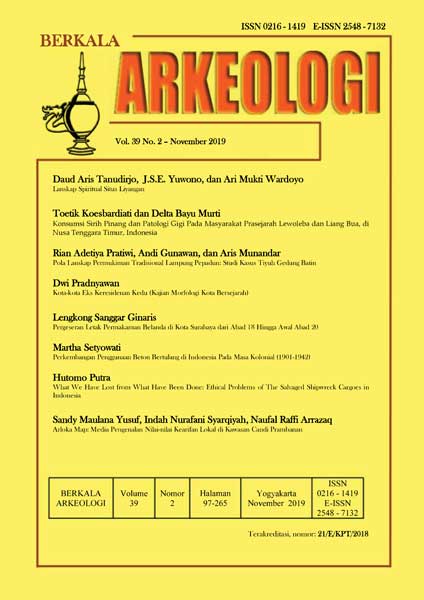WHAT WE HAVE LOST FROM WHAT HAVE BEEN DONE: ETHICAL PROBLEMS OF THE SALVAGED SHIPWRECK CARGOES IN INDONESIA
Main Article Content
Abstract
The struggling in the ethical issues of submerged underwater sites and underwater cultural heritage have been undertaking in Indonesia for the last two decades. During these 20 years, commercial companies in collaboration with the National Shipwreck Committee recovered and salvaged substantial numbers of material cargoes. Unfortunately, the majority of these operations occurred without the involvement of archaeologists and lack of proper and controlled archaeological methods and excavation techniques. Since 2010, the Indonesian Government has declared a moratorium that temporarily stopped all commercial survey and salvage activities, and prohibits the sale of the artefacts. Nowadays, more than 190,000 artefacts raised by salvagers are currently stored at the National Shipwreck Committee warehouses near Jakarta, in Cileungsi, West Java, Indonesia. This study attempts to illustrate the disadvantages of the commercial salvage practices and the auction of salvaged artefacts. This research also discusses some recommendations to contribute to a more ethical system of protection and the long-term management of the Indonesian maritime cultural resources, including its existing collections from salvaged shipwreck sites that are stored at the National Shipwreck Committee warehouse today.
Article Details

This work is licensed under a Creative Commons Attribution-NonCommercial-ShareAlike 4.0 International License.
References
Adams, J.L. (2010). New Directions in International Heritage Management Research. (Unpublished PhD Thesis Anthropology). University of Minnesota, Minnesota.
Arnold, J.B. and S.R. Weddle. (1978). The Nautical Archaeology of Padre Island: The Spanish Shipwrecks of 1554. New York: Academic Press.
Bass, G.F. (2011). The Development of Maritime Heritage. In A. Catsambis, B. Ford, and D.L. Hamilton (eds), The Oxford Handbook of Maritime Archaeology, pp. 3–24. Oxford: Oxford University Press.
Bass, G.F. (1983). Shipwrecks and Treasure Hunter. Journal of Field Archaeology, 10, 389.
Bass, G.F. (1966). Archaeology Underwater. London: Thames & Hudson; New York: Frederick A. Praeger.
Binford, L.R. (1972). An Archaeological Perspective. New York, Seminar Press.
Cederlund, C.O. and F. Hocker. (2006). Vasa 1: The Archaeology of a Swedish Warship of 1628. Stockholm.
Childe, V.G. (1936). Man Makes Himself. Watts: London.
Crumlin-Pedersen, O. and O. Olsen (eds.). (2002). The Skuldelev Ships 1: Ships and Boats of the North, vol. 4.1. Roskilde: Viking Ship Museum.
Du Plat Taylor, Joan, (ed.). (1965). Marine Archaeology. London: Hutchinson.
Edwards, H. (2000). Treasures of the Deep. The Extraordinary Life and Times of Captain Mike Hatcher. Pymble (New South Wales): HarperCollins.
Eiseman, J.C. and Ridgway S.B. (1987). The Porticello Shipwreck: A Mediterranean Merchant Vessel of 415–385 B.C. Ed Rachel Series in Nautical Archaeology. College Station: Texas A&M University Press.
Fink, Arlene. (2005). Conducting Research Literature Reviews: From the Internet to Paper, 2nd ed. Thousand Oaks, CA: SAGE Publications.
Flatman, J. (2007). The Origins and Ethics of Maritime Archaeology Part 1. Public Archaeology, 6(2), 77–97.
Flatman, J. (2007). The Origins and Ethics of Maritime Archaeology Part 2. Public Archaeology, 6(3), 141–154.
Flecker, M. (2012). The Ethics, Politics, and Realities of Maritime Archaeology in Southeast Asia. The International Journal of Nautical Archaeology, (31.1), 12–24.
Flecker, M. (2002). The Archaeological Excavation of the 10th Century Intan Shipwreck. BAR International Series 1047. Oxford: Archaeopress.
Frost, H. (1963). Under the Mediterranean: Marine Antiquities. Englewood Cliffs, NJ: Prentice–Hall.
Goggin, J.M. (1959—1960). Underwater Archaeology: Its Nature and Limitations. American Antiquity, 25, 348–354.
Grenier, R. B. and W. Stevens, (eds.). (2007). The Underwater Archaeology of Red Bay: Basque Shipbuilding and Whaling in the 16th Century, 5 vols. Ottawa: Canada.
Green, J.N. (1977). The Loss of the Verenigde Oostindische Compagnie jacht Vergulde Draeck, Western Australia 1656. Oxford: British Archaeological Reports Supplementary Series 36(i).
Guarinello, N.L. (2005). Archaeology and the Meanings of Material Culture. In P.P. A. Funari, A. Zarankin, & E Stovel (eds). Global Archaeological Theory: Contextual Voices and Contemporary Thoughts, (1):19–27. New York: Kluwer Academic/Plenum Publishers.
Hodder, I. (1992). Theory and Practice in Archaeology. London: Routledge.
Johnston, P.F. (1997). “Nanking Cargo Wreck.†In Encyclopaedia of Underwater and Maritime Archaeology, J. P. Delgado (ed.), pp.287–88. London: British Museum Press.
Keith, D.H. (1980). A Fourteenth-Century Shipwreck at Sinan-gun. Archaeology, 33(2), 33–43.
Lenihan, D.J. (1983). Rethinking Shipwreck Archaeology: A History of Ideas and Considerations for New Directions. In R. Gould (ed.), Shipwreck Anthropology, pp. 37–64. Albuquerque: University of New Mexico Press.
Maarleveld, T.J. (2011). Ethics, Underwater Cultural Heritage, and International Law. In A. Catsambis, B. Ford; D. L Hamilton the Oxford Handbook of Maritime Archaeology, pp. 917–941. Oxford: Oxford University Press.
Martin, C. (1975). Full Fathom Five: Wrecks of the Spanish Armada. New York: Viking.
McManamon, F.P. (2005). The Public Interpretation of America’s Archaeological Heritage. SAA Archaeological Record, 22–23.
Muckelroy, K. (1978). Maritime Archaeology. Cambridge University Press, Cambridge. Piercy, R. 2005 The Tragedy of the Santo Antonio de Tanna: Mombasa, Kenya. In G. F. Bass (ed.), Beneath the Seven Seas, pp. 172–179. London: Thames & Hudson.
Prown, J.D. (1982). Mind in Matter: An Introduction to Material Culture Theory and Method. Winterthur Portfolio Spring 17(1): 1-19.
Rowley, J., & Slack, F. (2004). Conducting a literature review. Management research news, 27(6), 31-39.
Sheaf, C. and R. Kilburn. (1988). The Hatcher Porcelain Cargoes: The Complete Record. Oxford: Phaidon.
Smith, D.H. and C.D. Alastair. (2003). The Management of the Underwater Cultural Heritage. Journal of Cultural Heritage, (4), 25–33.
Staniforth, M. (1996). Tracing Artefact Trajectories following Chinese Export Porcelain. Bulletin of the Australian Institute for Maritime Archaeology), 20(1), 13-18.
Thomas, J. (1996). Time, Culture, and Identity: An Interpretive Archaeology. London: Routledge.
Throckmorton, P. (1990). The World’s Worst Investment: The Economics of Treasure Hunting with Real Life Comparisons. Florida: Nova University.
Van Tilburg, H.K & M. Staniforth, (2012). Archaeological Publication. In Training Manual: for the UNESCO Foundation Course on the Protection and Management of Underwater Cultural Heritage in Asia and the Pacific. Published by UNESCO Bangkok, Thailand.
Viduka, J.A. (2012). Material Culture Analysis. Training Manual for the UNESCO Foundation Course on the Protection and Management of Underwater Cultural Heritage in Asia and the Pacific. Thailand: UNESCO Bangkok.

